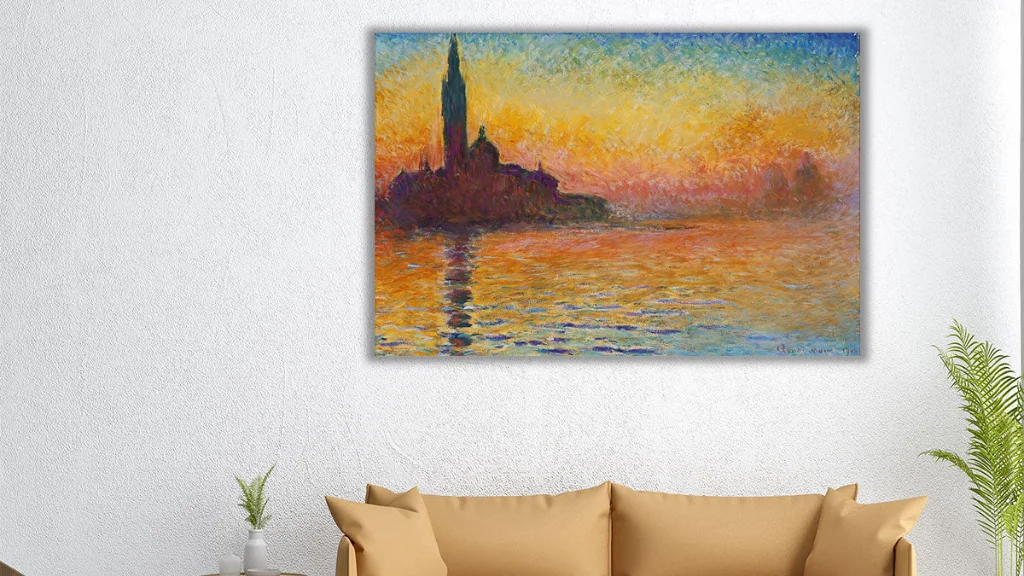As the founder of Impressionism, Claude Monet demonstrated exceptional skill in portraying short-lived light and color effects in his paintings. His paintings create emotional depth and movement, bringing them to life through his artistic techniques. The reflective effects in his Water Lilies along with the colorful Impression, and Sunrise paintings from Monet continue to draw worldwide audiences to his artwork. What specific elements create the captivating quality of his colors remains a mystery. The combination of perception science and his selected pigments together with his unique techniques explains Monet’s canvas prints in detail.
The Way Monet Interpreted Light And Color
Light fascinated Monet because it shaped the way he observed the natural environment. Throughout his career, he recognized that colors transform based on the time of day, the weather, and the angle from which viewers observe them. Traditional artists employed black to generate shadows yet Monet eliminated its use from his paintings. He produced lifelike shadows by placing opposing color pairs such as blue with orange and purple with yellow. Through optical mixing, he created an illusion of depth and vibrant tones that surpass the appearance of flat uninteresting shades.
Through his keen eye, he decided to paint the same subject multiple times across different lighting situations. Through his Haystacks and Rouen Cathedral series of Monet prints, Monet showed viewers how sunlight changes during the day and affects both color appearance and scene atmosphere. Through this method, both Impressionist art underwent significant change and scientists improved their knowledge of color theory.
Monet’s Choice of Pigments and Their Effect
The choice of pigments by Monet creates the sensation of life in his artwork. During his time of artistic practice, synthetic pigments started becoming common which allowed him to work with a wider range of vivid colors. He favored these pigments among others in Monet art prints:
- Cobalt Blue served as a vivid pure blue that deepened both skies and water elements.
- The artist used Viridian Green in his landscapes to achieve deep natural greens.
- Cadmium Yellow served as a brilliant yellow pigment which brought out the intense glow of sunlight and flowers.
- Alizarin Crimson functioned as a deep red pigment which brought out contrasting warmth in his paintings.
The intense pigments enabled Monet to stack colors which produced effects of reflected light on his paintings. You can observe in Monet’s canvas prints how his brushstroke technique with thick short marks produces lively textures and movements throughout the artwork.
The Science of Perception in Monet’s Art
Claude Monet’s prints or artworks become extraordinary because his color creations have a unique relationship with human visual perception. Monet chose to position different colors directly adjacent to each other on his canvas rather than spending time blending them on his palette. When using simultaneous contrast in his paintings, Monet achieved enhanced color brightness and intensity. When bright yellow stands beside deep purple the viewer perceives stronger intensity in both colors than when they exist separately.
The brain responds differently when viewing Monet’s work because he chose to represent pure colors instead of drawing rigid outlines. The natural blending of colors in our eyes creates a shimmering effect when observing his paintings which produces a dreamlike quality. The painting Impression Sunrise stands out because it showcases this effect which established the name of Impressionism.
Monet’s Influence on Modern Decor
The artistic works of Monet continue to motivate both art lovers and interior designers throughout the present day. Every living space benefits from the addition of Monet prints which bring both elegance and vibrancy to bedrooms and offices as well as living rooms. The peaceful atmosphere of Water Lilies emerges from its soft pastel colors and Sunset on the Seine uses fiery oranges and blues to generate dramatic warmth.
The majestic appearance of framed Monet prints functions as incredible central displays that create the complete environment of a space. His artwork works well in both traditional and contemporary interior settings no matter if you choose a classical framing option for his artwork or a modern large canvas format. Acquiring Claude Monet prints will deliver the core elements of light, movement, and vibrant color to enhance your home environment. You can visit Framed Flair to buy some amazing Monet paintings from here. Get ready to be amazed!
Conclusion
Monet’s colorful artwork results from both artistic genius and scientific principles. His sophisticated knowledge of how light worked in tandem with color perception together with his pioneer methods for pigment use enabled him to make everlasting masterpieces that draw continuous admiration from viewers. His talent to animate colors through his art exists beyond museum exhibitions and extends to his Monet art prints that decorate homes worldwide.
Monet canvas prints and framed Monet prints provide daily access to his artistic genius for anyone who wishes to introduce Impressionist magic into their living space. Through his perfect skills of color manipulation, his artwork promises to inspire spaces in forthcoming generations.







